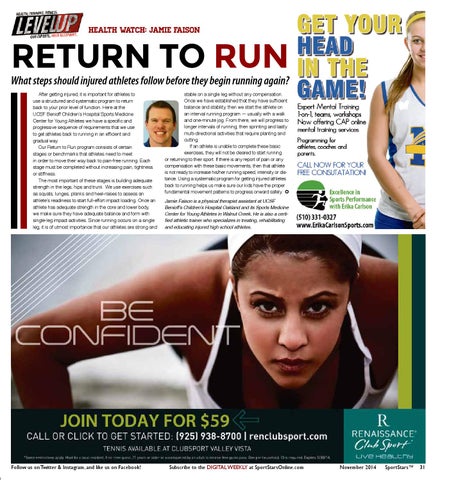health watch: jamie faison
ReTURN TO RUN What steps should injured athletes follow before they begin running again? After getting injured, it is important for athletes to use a structured and systematic program to return back to your prior level of function. Here at the UCSF Benioff Children’s Hospital Sports Medicine Center for Young Athletes we have a specific and progressive sequence of requirements that we use to get athletes back to running in an efficient and gradual way. Our Return to Run program consists of certain stages or benchmarks that athletes need to meet in order to move their way back to pain-free running. Each stage must be completed without increasing pain, tightness or stiffness. The most important of these stages is building adequate strength in the legs, hips and trunk. We use exercises such as squats, lunges, planks and heel-raises to assess an athlete’s readiness to start full-effort impact loading. Once an athlete has adequate strength in the core and lower body, we make sure they have adequate balance and form with single-leg impact activities. Since running occurs on a single leg, it is of utmost importance that our athletes are strong and
Follow us on Twitter & Instagram, and like us on Facebook!
stable on a single leg without any compensation. Once we have established that they have sufficient balance and stability, then we start the athlete on an interval running program — usually with a walk and one-minute jog. From there, we will progress to longer intervals of running, then sprinting and lastly multi-directional activities that require planting and cutting. If an athlete is unable to complete these basic exercises, they will not be cleared to start running or returning to their sport. If there is any report of pain or any compensation with these basic movements, then that athlete is not ready to increase his/her running speed, intensity or distance. Using a systematic program for getting injured athletes back to running helps us make sure our kids have the proper fundamental movement patterns to progress onward safely. ✪ Jamie Faison is a physical therapist assistant at UCSF Benioff’s Children’s Hospital Oakland and its Sports Medicine Center for Young Athletes in Walnut Creek. He is also a certified athletic trainer who specializes in treating, rehabilitating and educating injured high school athletes.
Subscribe to the DIGITAL WEEKLY at SportStarsOnline.com
November 2014
SportStars™
31
